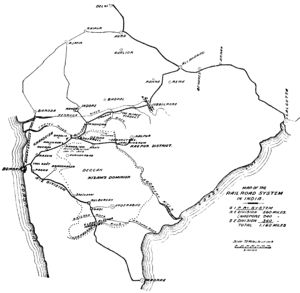Great Indian Peninsula Railway: Difference between revisions
HughWilding (talk | contribs) m Typo |
HughWilding (talk | contribs) Railwaymap added, minor editing |
||
| Line 94: | Line 94: | ||
== History == | == History == | ||
Formed in 1845, it was not until 1849 (at the urging of the then Governor, Lord Dalhousie) that the EIC sanctioned the GIPR to construct an experimental line, built to the broad gauge of 5' 6", eastward from Bombay. The first sod was turned on 31 October 1850 and the first locomotive was used in construction on 22 December 1851, but the first passenger train in India did not run until 16 April 1853, when a train, with 14 railway carriages and 400 guests, left [[Bombay]] bound for [[Thane]], hauled by three locomotives: ''Sindh, Sultan,'' and ''Sahib''. The 21 mile journey took an hour and fifteen minutes over the first section of the GIPR to be opened. | |||
By 1859, GIPR was tasked with "the construction and working of the following lines, all of which terminate at Bombay, - viz. from Bombay, ''via'' Callian, to Jubbulpore, to meet the East Indian Railway Company's line from Allahabad, with branches to Mahim and Nagpore - 870 miles; and from Callian, ''via'' Poonah and Sholapore, to the opposite side of the river Kristna, to meet the line, ''via'' Bellary, from Madras - 366 miles - total, 1,236 miles. Capital 10,000,000''l''l. Rate of Interest Guaranteed - 5 per cent. on 8,000,000''l''. capital, and 4½ per cent. on 333,000''l''. debentures, the balance to be raised upon arrangements to be hereafter made." <sup>(1)</sup> | |||
[[Image:India-rail-1870.jpg|left|thumb|Map of GIPR in 1870]] | |||
When, in 1871, the GIPR eventually reached [[Jubbulpore]] and linked to the [[East | When, in 1871, the GIPR eventually reached [[Jubbulpore]] and linked to the [[East Indian Railway]] (EIR), it completed Dalhousie’s dream of a Bombay-Calcutta route. | ||
On 30 June 1900, the assets of the GIPR were purchased by the GoI and merged with those of the [[Indian Midland Railway]] into a "new" GIPR, managed by the old company. | On 30 June 1900, the assets of the GIPR were purchased by the GoI and merged with those of the [[Indian Midland Railway]] into a "new" GIPR, managed by the old company. | ||
On 1 July 1925, the GoI took over direct control of the GIPR. | On 1 July 1925, the GoI took over direct control of the GIPR and transferred the [[Allahabad]] to [[Jubbulpore]] branch of the [[East Indian Railway|EIR]] to the GIPR. | ||
In 1951, the GIPR combined with the [[Nizam's Guaranteed State Railway]], the [[Dholpur State Railway]] and the [[Scinde State Railway]] to become Indian Railway's '''Central Railway'''. | In 1951, the GIPR combined with the [[Nizam's Guaranteed State Railway]], the [[Dholpur State Railway]] and the [[Scinde State Railway]] to become Indian Railway's '''Central Railway'''. | ||
| Line 134: | Line 136: | ||
[http://www.centralrailwayonline.com/aboutus.jsp History (of Central Railway)] ''Central Railway (Indian Railways)''. | [http://www.centralrailwayonline.com/aboutus.jsp History (of Central Railway)] ''Central Railway (Indian Railways)''. | ||
{{Railwaymap | |||
|railway= the North East Division | |||
|link= http://maps.google.com/maps/ms?ie=UTF&msa=0&msid=108089533651928306068.0004776aacede4ad4baa7 | |||
}} | |||
== Notes == | == Notes == | ||
1 "Money Market and City Intelligence", ''The Times'', Wednesday, 15 June 1859, #23333, 7a. | <sup>1</sup> "Money Market and City Intelligence", ''The Times'', Wednesday, 15 June 1859, #23333, 7a. | ||
Revision as of 02:37, 5 November 2009
| Great Indian Peninsula Railway | ||
|---|---|---|
 The Bombay-Poona Mail in full flight about 1910 | ||
| Line of route | ||
| Bombay to Raichur (SE Division} Bombay to Jubbulpore (NE Division)) Bhusawal to Delhi Bhusawal to Nagpur | ||
| Gauge / mileage | ||
| Broad gauge | 1562 miles (1905) | |
| Timeline | ||
| 1845 | Company formed | |
| 1853 | First section of line open to traffic | |
| 1871 | Through trains to Calcutta via Jubbulpore | |
| Dhond-Manmad State Railway absorbed | ||
| 1900 | Line acquired by State | |
| Key locations | ||
| Presidency | Bombay | |
| Stations | Kalyan, Poona, Hotgi, Wadi, Ahmadnagar, Akola, Chanda, Khandwa, Itarsi, Narsinghpur | |
| System agency | ||
| Worked by Great Indian Peninsula Railway | ||
| How to interpret this infobox | ||
| Great Indian Peninsula Railway | ||
|---|---|---|
 Great Indian Peninsula Railway device | ||
| System timeline | ||
| 1900 | Company re-formed to work State line | |
| 1925 | Government takes over working of system | |
| Constituent companies / lines | ||
| Great Indian Peninsula Railway | ||
| Agra-Delhi Chord Railway | ||
| Bhopal-Itarsi Railway | ||
| Bhopal-Ujjain Railway | ||
| Bina-Goona-Baran Railway | ||
| Gwalior Light Railway | ||
| 1900 | Indian Midland Railway | |
| Key locations | ||
| Headquarters | Bombay | |
| Workshops | Parel | |
| Major Stations | Agra, Ahmadnagar, Akola, Amraoti, Banda, Bhopal, Bhusawal, Cawnpore, Chanda, Delhi, Dholpur, Gwalior, Hotgi, Itarsi, Jhansi, Jubbulpore, Khandwa, Muttra, Nagpur, Narsinghpue, Poona, Raichur, Saugor, Wadi | |
| Successor system / organisation | ||
| 1951 | Central Railway (IR zone) | |
| System mileage | ||
| Broad gauge | 2988 miles (1905) 3363 miles (1943) | |
| 2' 0" NG | 183 miles (1905) 202 miles (1943) | |
| Associated auxiliary force | ||
| Great Indian Peninsula Railway Regiment | ||
| How to interpret this infobox | ||
Like most of the early railways in India, the Great Indian Peninsula Railway (GIPR) was a British company, registered in London, privately owned and financed, operating under licence and guarantee from the (British) Board of Control in India and the East India Company (EIC).
History
Formed in 1845, it was not until 1849 (at the urging of the then Governor, Lord Dalhousie) that the EIC sanctioned the GIPR to construct an experimental line, built to the broad gauge of 5' 6", eastward from Bombay. The first sod was turned on 31 October 1850 and the first locomotive was used in construction on 22 December 1851, but the first passenger train in India did not run until 16 April 1853, when a train, with 14 railway carriages and 400 guests, left Bombay bound for Thane, hauled by three locomotives: Sindh, Sultan, and Sahib. The 21 mile journey took an hour and fifteen minutes over the first section of the GIPR to be opened.
By 1859, GIPR was tasked with "the construction and working of the following lines, all of which terminate at Bombay, - viz. from Bombay, via Callian, to Jubbulpore, to meet the East Indian Railway Company's line from Allahabad, with branches to Mahim and Nagpore - 870 miles; and from Callian, via Poonah and Sholapore, to the opposite side of the river Kristna, to meet the line, via Bellary, from Madras - 366 miles - total, 1,236 miles. Capital 10,000,000ll. Rate of Interest Guaranteed - 5 per cent. on 8,000,000l. capital, and 4½ per cent. on 333,000l. debentures, the balance to be raised upon arrangements to be hereafter made." (1)

When, in 1871, the GIPR eventually reached Jubbulpore and linked to the East Indian Railway (EIR), it completed Dalhousie’s dream of a Bombay-Calcutta route.
On 30 June 1900, the assets of the GIPR were purchased by the GoI and merged with those of the Indian Midland Railway into a "new" GIPR, managed by the old company.
On 1 July 1925, the GoI took over direct control of the GIPR and transferred the Allahabad to Jubbulpore branch of the EIR to the GIPR.
In 1951, the GIPR combined with the Nizam's Guaranteed State Railway, the Dholpur State Railway and the Scinde State Railway to become Indian Railway's Central Railway.
Records
The following are held in the India Office Records at the British Library.
- L/AG/46/12/86 : GIPR Lists of appointments (officers 1849-1885; workmen 1852-1880)
- L/AG/46/12/88 : GIPR Contracts of employment (officers 1886-1925; workmen 1881-1925)
Both of the above are indexed in
- Z/L/AG/46 : Index to UK Appointments to Indian Railways (1849-1925)
External Links
Solomon and Alice Tredwell, contractors for Bhore Ghat Instone Family Tree.
GIPR picture gallery Science & Society Picture Library.
GIPR picture gallery David Flitcroft's Photographs.
"Guaranteed Railways in India" Hansard 1803-2005 (accessed 04 December 2008)
History (of Central Railway) Central Railway (Indian Railways).

|
See our interactive map of the North East Division locations and routes on Google Maps | |
|---|---|---|
Notes
1 "Money Market and City Intelligence", The Times, Wednesday, 15 June 1859, #23333, 7a.